
In 2024, local businesses can’t rely on foot traffic alone. With Google becoming the modern-day Yellow Pages, businesses need to ensure they’re visible where it matters most—online.
Whether you’re running a small café or a dental practice, showing up in local search results can make all the difference. The key to improving your local presence? A well-executed local SEO audit.
This guide will walk you through 8 actionable steps to boost your local rankings using tools like Semrush and Google Business Profile. From auditing your listings to optimising your website, we’ve got you covered.
Let’s get started and make sure your business gets found!
First Things First, What Is Local SEO & Why Is It Important?
Local SEO is the process of optimising your online presence to attract more business from relevant local searches. These searches occur on Google and other search engines, often from users looking for services or products in their immediate area. It’s crucial for businesses that rely on local customers, such as restaurants, dental practices, retail stores, and service providers like plumbers or electricians.
Local SEO helps ensure that your business appears in local search results when potential customers are searching for the exact services you offer, boosting your visibility and driving more targeted traffic. This strategy is especially important as more consumers use mobile devices and voice search to find local businesses nearby, making it a key factor in competing and thriving in your local market.
Here are the essential steps to conduct a thorough local SEO audit and boost your rankings in local search results.
Step 1: Audit Your Google Business Profile (GBP)
Your Google Business Profile is like your online storefront—it’s often the first thing people see when searching for local businesses. So, it’s essential that your information is accurate and up to date.
1. Log in to your Google Business Profile account
- Visit the Google Business Profile website.
- Sign in with the Google account associated with your business.
Note: You need to claim and verify your GBP. This is the first step to ensure your business is accurately represented online.
2. Verify your business information
- Go to the “Info” section.
- Check that your business NAP (name, address, phone number), and hours of operation are correct and consistent with your website and other online listings.
- Make any necessary updates to ensure accuracy.
3. Review and update business categories
- Navigate to the “Info” tab.
- Verify that your primary and secondary categories accurately reflect your business offerings.
- If needed, add or change categories to better describe your business and match relevant search queries.
4. Optimise your business description
- Go to the “Info” section and find the Business description field.
- Add relevant keywords naturally into your description to improve search visibility.
- Keep the description clear and concise, highlighting what makes your business unique.
5. Check and add photos
- Visit the “Photos” tab.
- Ensure you have a variety of high-quality images, including your business exterior, interior, staff, and products or services.
- Upload new photos if needed to keep your profile fresh and engaging.
6. Manage customer reviews
- Go to the “Reviews” tab.
- Read through recent customer reviews and ensure you respond to both positive and negative feedback.
- Address any recurring issues or concerns mentioned in reviews.
7. Review business attributes
- Check the “Info” section for business attributes like accessibility features, payment options, and service offerings.
- Update attributes to reflect any new features or services.
8. Verify and update service areas (if applicable)
- Navigate to the “Info” tab.
- Ensure your service areas are accurate if your business serves multiple locations or operates in specific regions.
- Adjust service areas as needed to reflect your current operations.
9. Check for consistency across platforms
- Compare your GBP information with details on your website and other online listings (e.g., Yelp, Facebook).
- Ensure consistency to avoid confusing potential customers and to strengthen your local SEO.
Pro Tip: Keep an eye out for Google’s suggestions and updates. They often recommend updates based on search trends or customer activity, so staying on top of these can give you an edge.
Step 2: Perform a Local Keyword Research Using Semrush
Finding the right keywords is crucial for attracting local customers. Semrush’s Keyword Magic Tool is a powerful resource to help you discover high-volume, location-specific keywords.
1. Log in to your Semrush account
- Go to the Semrush website.
- Sign in with your account credentials. If you don’t have an account, you can sign up for a free trial.
2. Access the Keyword Magic Tool
- From the Semrush dashboard, select the SEO drop down
- Click on “Keyword Magic Tool” in the left-hand side menu to open the keyword research interface.
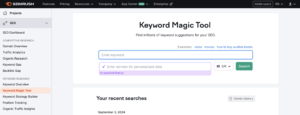
3. Enter a seed keyword
- In the search bar, enter a broad keyword related to your business (e.g., “dentist” or “plumber”).
- From the drop-down, select the country you’re trying to rank for that keyword in
- Click the “Search” button to initiate the keyword search.
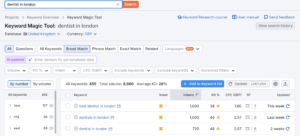
4. Save and organise keywords
- Select relevant keywords from the list by checking the boxes next to them.
- Click “Add to Keyword list” to save your chosen keywords.
5. Export keyword data
- For further analysis or to share with your team, export the keyword data by clicking on the “Export” button.
- Choose your preferred file format (e.g., CSV or Excel) to download the data.

Start by searching for keywords that include your city or neighborhood. For example, if you run a dental practice, look for terms like “dentist in [city]” or “best orthodontist near [city].”
Review the keyword metrics provided by Semrush. Aim for keywords with a good balance of high search volume and manageable difficulty. This helps ensure you target terms that can drive significant traffic without being overly competitive. Look for specific, longer phrases related to your business and location. Long-tail keywords, like “affordable family dentist in [city],” often have lower competition and are more likely to attract local customers with specific needs.
Step 3: Audit On-Page SEO for Local Keywords
Optimising your website’s on-page elements for local keywords ensures that search engines and potential customers can easily find and understand your business. For this we move away from Semrush and turn to Screaming Frog.
1. Download and Install Screaming Frog
- Visit the Screaming Frog website and download the SEO Spider tool.
- Install it on your computer, and open the application.
2. Crawl Your Website
- In the Screaming Frog interface, enter your website URL into the search bar at the top and click the green “Start” button.
- Screaming Frog will begin crawling your website, gathering data on all your pages.
3. Analyse Meta Titles and Descriptions
- Once the crawl is complete, go to the “Page Titles” tab to view the meta titles for each page.
- Similarly, click on the “Meta Descriptions” tab to see the meta descriptions for each page.
- Review these to ensure they include relevant local keywords (e.g., “Best Plumber in [City]” or “Invisalign Treatment in [City]”).

4. Optimise Titles and Descriptions for Local SEO
- Export the list of titles and descriptions into a spreadsheet.
- Edit your meta titles and descriptions to ensure they include your local keywords, are within the recommended character limits, and provide clear, compelling information.
- Check for any missing or duplicate meta data and make sure to reflect your business’s location in meta titles (e.g., “Best Bakery in [City]”).
- Apply changes to your website’s CMS
5. Audit H1 Tags
- Go to the “H1” tab to view the headers on each page.
- Check for any missing or duplicate H1 tags, and ensure they also include relevant local keywords.
6. Ensure NAP consistency
- Manually check your website’s pages to verify that your NAP details are correct
- This information should be clearly visible on all pages, typically in the header or footer.
7. Add location-specific content
- Identify opportunities to include location-specific content on your site. This can be city-specific pages or blog posts about local events or news.
- Create or update content to include relevant local keywords, which can help improve your site’s relevance to local search queries.

8. Add local Schema Markup
- Add structured data to your site to help search engines better understand and display your business details
- Write the schema markup (see the example below) and get your developers to implement it on your website
- For example, use LocalBusiness schema to mark up your business name, address, phone number, and operating hours.
Step 4: Check Local Listings Consistency
Maintaining consistent business information (Name, Address, Phone—NAP) across all online listings is critical for local SEO. Inconsistent listings can confuse both search engines and potential customers, which can harm your local search rankings. Ensuring that your NAP details are consistent across all platforms helps establish trust and authority with search engines, which can boost your local rankings.
Use Semrush’s Listing Management Tool to audit your business listings across directories.
1. Access Semrush’s Listing Management Tool
- Log in to your Semrush account.
- Click the “Local” drop-down and select “Listing Management Tool” in the left-hand side menu
- Enter your business details to start scanning for listings across various directories.
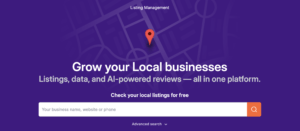
2. Review NAP information on top directories
- After the tool scans for your business listings, review the results for directories like Yelp, Yellow Pages, Facebook, Google Business Profile, and more.
- Verify that your NAP are consistent across all platforms.
- If any listings are missing information or contain discrepancies, mark them for correction.
3. Fix discrepancies between listings
- Use the “Listing Management Tool” to automatically fix any discrepancies. Some directories may allow auto-updates via Semrush, while others may require you to log in manually and make changes.
- Focus on correcting major inconsistencies like wrong addresses, old phone numbers, or variations of your business name.
4. Add your business to relevant local directories
- Identify any important local directories where your business is not listed yet.
- Add your business to these directories, ensuring that all NAP details are accurate and match your website and other online listings.
- If your business predominantly serves the UK, try also using the following searches to find relevant local directories:
- site:.co.uk directory
- site:.co.uk web directory
- site:.co.uk local listings
- site:.co.uk local directory
- site:.co.uk “submit site”
- site:.co.uk “get listed”
Step 5: Analyse Local Competitors
It’s important to keep an eye on your local competition to find opportunities for improvement. By understanding what’s working for your competitors, you can replicate their successes and capitalise on areas where they may be falling short. Semrush offers powerful tools to give you a comprehensive view of your competitors’ strategies, from backlinks to content optimisation.
1. Identify top local competitors:
- Find out which competitors are ranking above you in search results for your target local keywords.
- If you live in the location you’re targeting (we know this is unlikely) then just Google your target keywords
- You can also look up your keywords on Semrush using the “Keyword Overview” tab in the left-hand side menu – this allows you to select the location.
- Enter your keyword into the search bar and click “Search”. Scroll down to “SERP Analysis” and you’ll see the top ranking pages for that keyword in the location you chose.
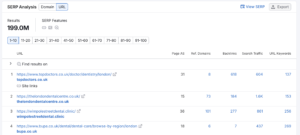
2. Analyse their backlink strategy:
- Use Semrush’s “Backlink Analytics Tool” to investigate your competitors’ backlink profiles.
- Focus on local backlinks such as those from community websites, local media, or industry-specific directories.
- Using a “Backlink Gap Analysis” find potential link-building opportunities by targeting websites that your competitors are already benefiting from.
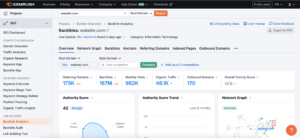
3. Evaluate their content strategy:
- Review competitors’ content, including how they structure title tags, meta descriptions, and headers.
- Assess the strength of their local keyword usage and whether they’re creating location-specific content (e.g., blog posts about local events).
- Identify gaps where they may not be covering certain local topics, allowing you to fill that content void.
4. Audit their GBP:
- Compare their GBP profiles to yours. Search for them on Google and see what pops up. Do they have more reviews? Are their categories better optimised? Are they uploading new images regularly?
- Identify areas where you can enhance your GBP to stand out.
5. Spot keyword gaps:
- Use Semrush’s “Keyword Gap Tool” to find local keywords that your competitors rank for but you don’t.
- Enter your domain and your competitor’s domain and click “Compare”
- Prioritise optimising for these missing keywords to gain a competitive edge.
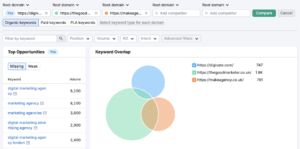
Pro Tip: Outperform your competitors by improving weak areas such as user reviews, GBP optimisation, or mobile performance. Being more consistent or up-to-date can give you the edge in local rankings.
Step 6: Assess Local Backlinks with Semrush
Building a strong local backlink profile is crucial for boosting your authority and improving your local rankings. Backlinks from relevant, local sources signal to search engines that your business is trusted within the community. Securing local backlinks from trusted and authoritative sources boosts your visibility, making it easier for search engines to rank your business higher in local searches.
Semrush makes it easy to audit your current backlink profile and identify opportunities to grow it.
1. Evaluate your backlink portfolio:
- Open Semrush’s “Backlink Audit Tool” and enter your domain.
- Analyse the local backlinks you already have, paying attention to links from local directories, newspapers, community sites and local top-level domains.
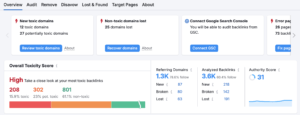
2. Disavow toxic links:
- Identify any low-quality or toxic backlinks that could harm your local rankings.
- Use Semrush’s or Google’s Disavow Tool to prevent these from negatively affecting your SEO. But, be extra careful with this. Once you disavow something it’s difficult to get it back.
- Assemble your list of pages or domains to disavow in a text file
- Choose the property from the list you want to update. If a disavow list already exists, you’ll see a summary of disavowed pages and domains.
- Click the upload button and select the disavow file from your computer.
- If there are errors in the file, they will be displayed, and the existing list will remain unchanged. Correct the errors and try uploading again.
- If the upload is successful, it may take a few weeks for Google to process and incorporate the new disavow list.
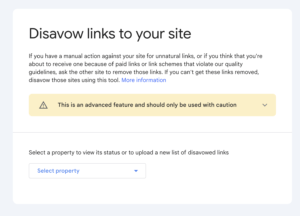
3. Build more local backlinks:
- Reach out to local community websites, bloggers, or businesses for backlink opportunities.
- Consider sponsoring local events or charities to gain backlinks from their sites.
4. Track competitor backlinks:
- Use Semrush to monitor your competitors’ backlinks and identify sources where they’ve earned valuable links.
- Do a “Backlink Gap Analysis” to find websites your competitors have links from which you don’t yet and then contact the local ones in the list that are relevant to you.
- Add your domain and your competitor’s domain and click “Compare”
- You’ll now see a list of websites that link to your competitors but not to you
- It is sorted by the number of competitors that have a link from that website and then the authority score
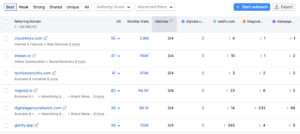
Step 7: Review and Respond to Google Reviews
Customer reviews can significantly influence your local search rankings and customer trust. Encouraging positive reviews and responding to them thoughtfully boosts your reputation and signals to Google that your business is active and engaged. Google reviews are a crucial factor in local SEO, so regularly reviewing and responding to feedback is essential.
1. Respond to all reviews:
- Take the time to respond to both positive and negative reviews. Engage with happy customers and address any concerns raised in negative feedback professionally and promptly.
2. Encourage more reviews:
- After a positive interaction with a customer, kindly ask them to leave a review on your GBP. The more recent, positive reviews you have, the better it will look to potential customers and Google’s ranking algorithms.
3. Monitor your reputation:
- Regularly check your GBP for new reviews and respond quickly. Show that you care about customer feedback, which will help build trust.
Step 8: Track Local Rankings Using Semrush
Tracking your local rankings regularly helps you understand the effectiveness of your SEO efforts and allows you to adjust your strategy when needed. With Semrush’s tracking tools, you can monitor keyword positions, identify ranking changes, and refine your local SEO tactics to stay competitive in your area.
1. Set up local rank tracking:
- In Semrush, navigate to the “Position Tracking Tool.”
- Enter your domain, target keywords, and specify your geographic location to track local search rankings specifically.
2. Monitor target keywords:
- Click “Overview” and scroll down to “Rankings Overview” to see your keyword changes
- Focus on your most important local keywords (e.g., “dentist in [city]” or “[service] near me”).
- Track how well your business ranks for these terms in local search results and how your rankings change over time.
3. Analyse ranking fluctuations:
- Review any significant changes in your keyword rankings. Investigate what may have caused a drop (e.g., a competitor’s increased efforts, a Google algorithm update, or technical issues on your website).
- If you notice positive ranking changes, consider replicating successful tactics across other pages or keywords.
4. Adjust your SEO strategy:
- Based on the data from your rank tracking, update your content, backlinks, or on-page SEO to improve rankings for underperforming keywords.
- Ensure you stay competitive by continuously optimising for the keywords driving traffic and leads to your local business.
Local SEO Audit Complete
Congratulations! You’ve just taken a big step toward improving your local search visibility. By following this guide, you’ve optimised your Google Business Profile, ensured your on-page SEO aligns with local keywords, and even used Semrush to track and monitor your progress. Each step of this audit empowers you to better serve your local audience and edge out your competition.
Remember, SEO is an ongoing process—continue to monitor your local listings, gather more positive reviews, and adjust your strategy as needed to stay ahead. Local SEO isn’t just about being seen, it’s about building trust, engaging with your community, and making it easy for customers to find you when it matters most.
With these tools and strategies in hand, you’re ready to conquer local SEO and boost your rankings like a pro!



